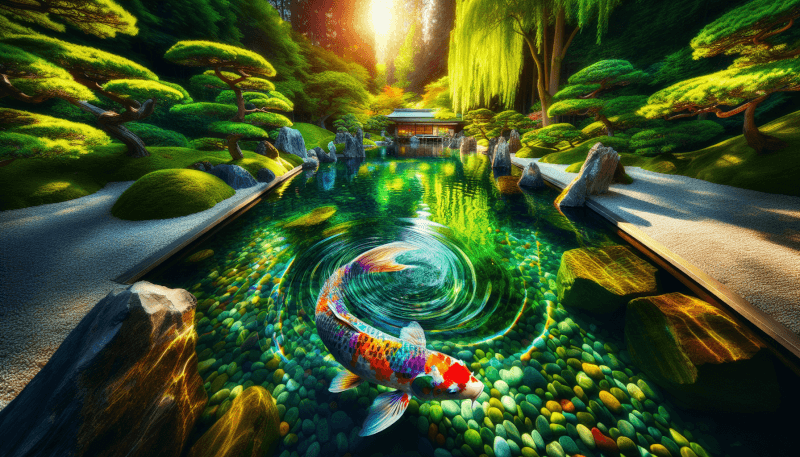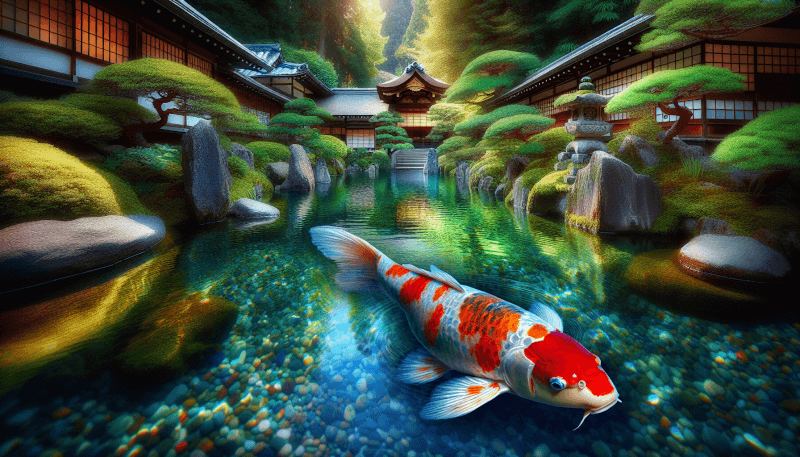Immerse yourself in the captivating world of Japanese aquarium aesthetics as you discover the true beauty and serenity that awaits within these marine wonderlands. From the meticulously curated displays of marine life to the harmonious blend of art and nature, Japanese aquariums offer an unparalleled experience that will leave you in awe. Discover the tranquility that comes from observing the graceful movements of colorful fish and the mesmerizing interplay of light and water. With each visit, you’ll uncover a new dimension to the art of aquarium design, making it an adventure that is both visually stunning and spiritually enriching. Embark on a journey through the depths of Japan’s aquatic wonders and be prepared to be captivated by the symphony of beauty that awaits.

History of Japanese Aquarium Aesthetics
Origins of Japanese Aquarium Aesthetics
Japanese aquarium aesthetics have a rich history that dates back centuries. It all began with the Japanese fascination with nature and the desire to bring its beauty indoors. The concept of creating miniature landscapes, known as “bonsai,” played a significant role in shaping the early Japanese aquarium aesthetics. This practice laid the foundation for the idea of replicating natural environments on a smaller scale, giving birth to the art of aquascaping.
Influence of Zen Philosophy
Zen philosophy has deeply influenced Japanese aquarium aesthetics. The principles of simplicity, balance, and harmony that are central to Zen teachings are reflected in the design principles of Japanese aquariums. Zen encourages the observer to appreciate the beauty and tranquility of nature, which is precisely what Japanese aquarium aesthetics seek to evoke.
Evolution of Japanese Aquarium Design
Japanese aquarium design has evolved over time, incorporating new techniques and ideas. In the mid-20th century, Takashi Amano, a renowned aquarist and photographer, revolutionized the art of aquascaping. Amano’s approach focused on creating naturalistic layouts, merging elements of landscape design and aquatic plant arrangements. His innovative techniques garnered international recognition and played a critical role in popularizing Japanese aquarium aesthetics worldwide.
Design Principles in Japanese Aquarium Aesthetics
Elegance and Simplicity
Japanese aquarium aesthetics emphasize elegance and simplicity. The design should be visually pleasing while maintaining a sense of minimalism. By removing unnecessary elements and clutter, a Japanese-style aquarium creates a serene and harmonious atmosphere.
Balance and Harmony
Balance and harmony are vital principles in Japanese aesthetics, both in art and aquarium design. The arrangement of rocks, plants, and other elements should create a sense of balance, mimicking the harmony found in nature. This principle ensures that every component of the aquarium feels like it belongs, creating an overall cohesive and pleasing composition.
Naturalistic Layout
Japanese aquarium aesthetics strive to recreate the natural beauty of aquatic environments. The layout typically includes a combination of rocks, aquatic plants, and driftwood arranged to resemble a natural landscape. The goal is to create a sense of immersion, making the viewer feel like they are gazing into a slice of nature.
Minimalist Use of Color
Japanese aquarium aesthetics favor a minimalist approach to color. The focus is on shades of green, achieved through various types of aquatic plants. The limited use of other colors, such as shades of brown and earthy tones, adds a sense of authenticity to the aquatic landscape.
Incorporation of Nature
One of the key principles of Japanese aquarium aesthetics is to incorporate elements of nature. This can include the use of natural materials such as rocks and driftwood, or even the introduction of small aquatic creatures like snails or shrimp. By bringing in these natural elements, the aquarium becomes a microcosm of a natural ecosystem.
Reflection and Tranquility
Reflection and tranquility are important aspects of Japanese aquarium aesthetics. The stillness of the water surface, with its reflections of the plants and surrounding elements, adds to the sense of serenity. By creating a peaceful and calming environment, Japanese aquarium aesthetics offer a space for contemplation and relaxation.

The Role of Aquatic Plant Life
Importance of Aquatic Plants in Japanese Aquariums
Aquatic plants play a central role in Japanese aquarium aesthetics. Beyond their decorative value, aquatic plants offer numerous benefits to the overall health and balance of the aquarium. They oxygenate the water, provide shelter for fish and other aquatic creatures, and help maintain water quality by absorbing excess nutrients.
Selection and Placement of Aquatic Plants
Careful consideration is given to the selection and placement of aquatic plants in Japanese aquarium aesthetics. The choice of plants depends on their growth habits, compatibility with other species, and aesthetic qualities. Taller plants are typically placed towards the back of the aquarium to create depth, while shorter plants are placed towards the front to maintain a sense of foreground.
Use of Mosses and Ferns
Mosses and ferns are frequently used in Japanese aquarium aesthetics to enhance the naturalistic appearance. Mosses, with their velvety texture, are often meticulously attached to rocks or driftwood to create a lush and inviting environment. Ferns, with their delicate fronds, add a touch of elegance and bring a sense of movement to the aquarium.
Creating Depth and Dimension
Japanese aquarium aesthetics strive to create a sense of depth and dimension within the limited space of the aquarium. This is achieved through strategic placement of rocks, driftwood, and aquatic plants. By arranging these elements in layers, with taller elements in the background and shorter elements in the foreground, the aquarium is transformed into a captivating, three-dimensional landscape.
Art of Rock Arrangement
Traditional Use of Rocks in Japanese Aquariums
Rocks are an essential component of Japanese aquarium aesthetics, as they serve as the backbone of the design. Japanese aquariums often feature carefully selected and arranged rocks that resemble natural landscapes. These rocks, known as “seiryu stone” or “ryuoh stone,” are prized for their unique shapes, textures, and colors.
Creating Naturalistic Landscapes
The art of rock arrangement in Japanese aquarium aesthetics aims to create naturalistic landscapes that mirror the beauty of nature. Rocks are positioned to mimic mountains, cliffs, or riverbanks, giving the illusion of a miniature landscape within the aquarium. The use of different-sized rocks and careful attention to their placement provide a realistic and captivating scene.
Placement and Stacking Techniques
Japanese aquarium aesthetics employ specific placement and stacking techniques to achieve a harmonious and natural look. Rocks are often stacked in a way that appears organic, with irregular shapes and varying heights. This technique, known as “Iwagumi” style, creates a visually striking focal point and draws the viewer’s attention towards the carefully arranged rocks.

Fish Selection and Care
Native Japanese Fish Species
Japanese aquarium aesthetics often feature native fish species that are well-suited to the aquatic environment. Some popular native Japanese fish include koi, goldfish, guppies, and betta fish. These fish not only add visual interest to the aquarium but also thrive in the specific water conditions found in Japanese-style setups.
Maintaining Proper Water Conditions
Proper water conditions are crucial for the health and well-being of the fish in a Japanese-style aquarium. This includes maintaining the right temperature, pH level, and water hardness. Regular water testing and monitoring are necessary to ensure that the fish are living in an optimal environment.
Fish Compatibility
Careful consideration must be given to fish compatibility when designing a Japanese-style aquarium. Certain fish species may have different requirements or behaviors that need to be taken into account. It is important to choose fish that can coexist peacefully and thrive together in the same environment.
Importance of Water Filtration
Water filtration is of utmost importance in Japanese aquarium aesthetics to maintain a clean and healthy environment. Proper filtration systems ensure that waste, excess nutrients, and harmful substances are continuously removed from the water. This not only benefits the fish but also promotes the growth and vitality of the aquatic plants.
Incorporating Japanese Cultural Elements
Symbolism and Meaning in Japanese Aquariums
Japanese aquarium aesthetics often incorporate symbolism and meaning to create a deeper connection with the observer. Elements such as rocks, plants, and even the arrangement of the aquarium itself can hold cultural significance. For example, rocks may represent mountains, symbolizing strength and longevity, while certain plants may be associated with prosperity or spiritual beliefs.
Influence of Bonsai and Ikebana
The influence of bonsai, the art of growing miniature trees, and ikebana, the art of flower arrangement, is evident in Japanese aquarium aesthetics. The practice of shaping and pruning plants in bonsai and the attention to detail in ikebana have inspired aquascapers to create visually striking and meticulously arranged aquatic landscapes.
Shinto and Zen Elements
Shinto and Zen philosophies play a significant role in Japanese aquarium aesthetics. Shinto, a traditional Japanese religion, emphasizes harmony with nature, and the concept of creating a sacred space is mirrored in the design principles of Japanese aquascaping. Zen teachings, with their focus on mindfulness and simplicity, guide the aesthetics of Japanese aquariums, creating a space of tranquility and contemplation.
Tea House and Garden Influence
The influence of traditional Japanese tea houses and gardens can be seen in the design of Japanese-style aquariums. The calming and serene atmosphere of tea houses and the meticulous arrangement of elements in traditional gardens are reflected in the clean lines, balance, and naturalistic layouts of Japanese aquarium aesthetics.

Equipment and Technology in Japanese Style Aquariums
Quality Filtration Systems
To maintain the pristine conditions necessary for Japanese aquarium aesthetics, high-quality filtration systems are employed. These systems ensure water clarity, remove impurities, and support the overall health of the aquarium ecosystem.
LED Lighting for Aesthetics
LED lighting has become an essential aspect of Japanese aquarium aesthetics. By using specific light spectrums, aquarists can enhance the colors of aquatic plants and create a visually captivating environment. LED lighting also allows for precise control of lighting intensity and duration, promoting healthy plant growth while minimizing algae growth.
CO2 Injection and Water Quality Control
Carbon dioxide (CO2) injection is often used in Japanese-style aquariums to provide essential nutrients for aquatic plant growth. Controlling CO2 levels allows for optimal plant development and prevents nutrient deficiencies. Additionally, monitoring water quality parameters such as pH and dissolved oxygen levels is vital to ensure a healthy and thriving aquascape.
Aquarium Size and Shape
The size and shape of the aquarium are crucial considerations in Japanese aquarium aesthetics. Smaller, more compact tanks are favored to create a greater sense of intimacy and to highlight the details of the aquascape. The use of rimless tanks and specific shapes, such as cubes or shallow rectangles, adds to the overall visual appeal and harmonizes with the minimalist design principles.
Maintenance and Care Tips
Water Testing and Monitoring
Regular water testing and monitoring are essential to ensure optimal water conditions in a Japanese-style aquarium. Testing parameters such as ammonia, nitrite, nitrate, pH, and carbonate hardness allows for prompt action in maintaining a healthy environment for the fish and plants.
Pruning and Trimming Aquatic Plants
Pruning and trimming aquatic plants are necessary to maintain the desired shape and size of the aquascape. Removing excess growth or dead leaves prevents overcrowding and promotes the overall health of the plants. Care must be taken to use suitable tools and techniques to avoid damaging the vegetation.
Regular Cleaning and Water Changes
Regular cleaning and water changes are vital for the long-term success of a Japanese-style aquarium. Removing debris, algae, and excess organic matter helps maintain water quality and prevents the buildup of harmful substances. Water changes replenish vital nutrients and maintain optimal water parameters.
Preventing Algae Growth
Preventing algae growth is a constant challenge in Japanese aquarium aesthetics. Proper lighting duration, intensity, and spectrum, along with balanced nutrient levels and consistent maintenance, can help minimize algae outbreaks. Additionally, the introduction of algae-eating animals, such as snails or shrimp, can provide natural control.

Japanese Aquarium Aesthetics in Contemporary Design
International Influence and Popularity
Japanese aquarium aesthetics have gained international recognition and popularity. Aquarists from all over the world have embraced the principles and techniques of Japanese-style aquascaping, leading to the establishment of aquascaping competitions and communities dedicated to this art form.
Modern Interpretations of Japanese Style
Contemporary Japanese-style aquarium design has seen innovative and creative interpretations of traditional principles. While still honoring the core principles of Japanese aquarium aesthetics, aquarists have incorporated modern materials, unconventional layouts, and experimental techniques to push the boundaries of this art form.
Influence on Aquascaping Competitions
The influence of Japanese aquarium aesthetics can be seen in aquascaping competitions worldwide. These competitions showcase the talent and creativity of aquascapers, inspiring others to explore the beauty and serenity of Japanese aquarium aesthetics.
Challenges and Rewards of Japanese Aquarium Aesthetics
Japanese aquarium aesthetics present unique challenges and rewards to aquarists. The meticulous attention to detail and precise balance required may be challenging to achieve. However, the reward of creating a captivating and serene aquatic landscape, reminiscent of the natural beauty of Japan, is immeasurable.
Visiting Japanese Aquariums
Famous Japanese Aquariums
Japan is home to several world-renowned aquariums that showcase the beauty of Japanese aquarium aesthetics. The Osaka Aquarium Kaiyukan, Kyoto Aquarium, and Okinawa Churaumi Aquarium are just a few examples of the stunning exhibits available for visitors to explore.
Must-See Exhibits and Displays
Japanese aquariums feature a wide variety of exhibits and displays that highlight the uniqueness and diversity of aquatic life. From massive tanks housing majestic whale sharks to the delicate beauty of tropical fish and coral reefs, there is something for every aquatic enthusiast to enjoy.
Immersive Experiences and Interactive Features
Japanese aquariums go beyond traditional exhibits by offering immersive experiences and interactive features. From touch tanks where visitors can interact with various marine creatures to shows and performances that showcase the grace and athleticism of dolphins, these interactive elements make visiting a Japanese aquarium a truly unforgettable experience.
In conclusion, Japanese aquarium aesthetics have a deep-rooted history and a unique set of design principles that emphasize simplicity, balance, and harmony. The incorporation of elements from nature, such as rocks, plants, and aquatic life, creates a serene and captivating environment. With its influence on international aquascaping and popularity in contemporary design, Japanese aquarium aesthetics continue to inspire and delight enthusiasts worldwide. Whether visiting a famous Japanese aquarium or creating a Japanese-style aquascape at home, the beauty and serenity of Japanese aquarium aesthetics are an immersive experience to be cherished.

